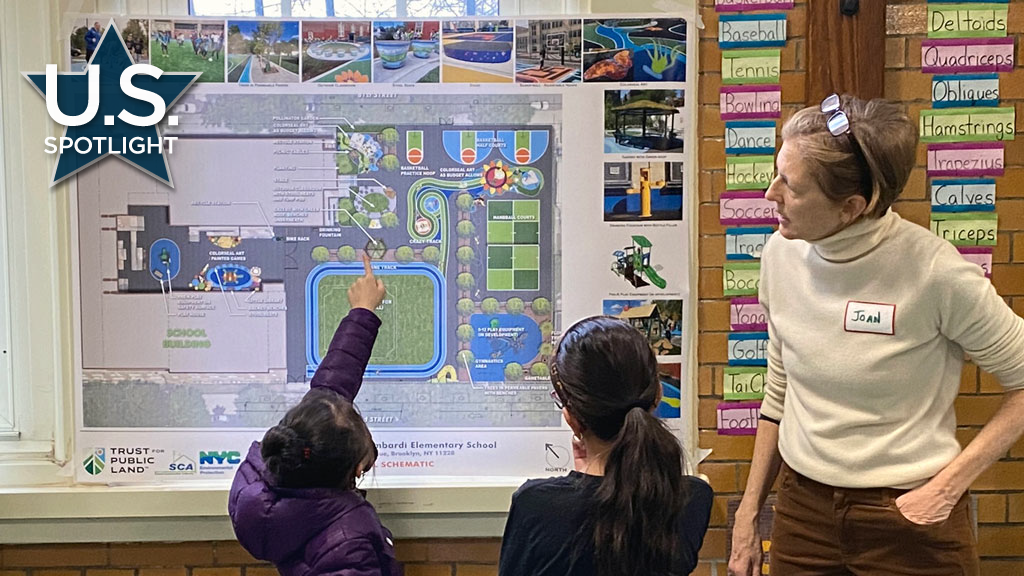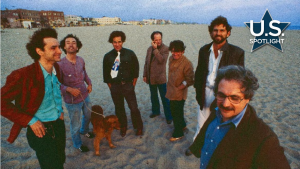Five public schools in New York City are replacing worn blacktop playgrounds with new green infrastructure designs, not only as recreational upgrades but also to mitigate flooding brought on by the changing climate.
Each costing about $2.3 million, the green playgrounds will use permeable materials to absorb or collect more than 3.5 million gallons of water that would otherwise run into storm sewers.
While that may raise eyebrows for what can be done with a little know-how, equally interesting is who is behind the new playground designs.
“We (Trust for Public Land) worked together with the schools to work with students to do the designs,” says Mary Alice Lee, New York City playgrounds program director of TPL.
In partnership with the New York City Department of Environmental Protection (DEP) and Studio HIP Landscape Architecture, the Trust’s staff has gone through a three-month design process with students for each school, ranging from elementary to high school.
While the design workload is tailored to each age group, a common objective is to teach the students about issues such as space, sun orientation, permeable/impermeable surfaces and measurements, says Liz Hand-Fry, principal landscape architect with Studio HIP.
Armed with design notebooks, students have been evaluating their playground sites for simple problems such as the location of puddles and cracked asphalt.
How to capture stormwater onsite that could otherwise contribute to flooding is emphasized in the class; it is not just about designing playing fields and climbing bars, says Lee.
Means of improving surface permeability include turf fields with gravel underlay, permeable membranes, trees, gardens and bioswales.
Some of the school sites include fitness equipment, running tracks, outdoor classrooms, picnic and games tables, bleachers, even ping pong tables and in one case an amphitheatre.
Lee says resilient elements have to be factored into the designs because upwards of 1,000 students run and play on the grounds daily.
She adds students have had to design to a budget and make accommodations for other users such as school staff and community residents who will have access to the playgrounds in off-hours.
“We had them thinking about the idea of equity and what the items (in the space) would be for everyone to use,” says Lee.
Hand-Fry adds the student’s viewpoints are well regarded but they do have to do the work to get results.
“They pretty much go through what we go through when we design something.”
That participatory design process goes beyond the classroom, extending to the staff and surrounding neighborhoods.
Once the playgrounds are opened a “green team” will be formed consisting of students, staff and residents to help maintain the sites.
“We do things like identification workshops to determine things like what are the weeds and what are the flowers,” says Lee.
Under construction now, the playground projects will open in June and several more playgrounds will be under construction for planned openings in fall.
The construction contracts are awarded through a bid process.
The five playgrounds include two in Queens and one each in Brooklyn, Manhattan and The Bronx. Ranging in size, the green infrastructure playgrounds manage from 440,000 gallons to more than one million gallons of stormwater annually.
Over the past 25 years 226 playgrounds in New York City have been opened through the TPL in partnership with the DEP. Roughly 30 of those are green designs with the remainder having “green elements,” says Lee.
“The more recent ones since our partnership with the EP (Deptartment of Environmental Protection) are the ones that we’ve actively put in green infrastructure to manage the rainwater,” she says.
Ultimately, the goal of the program is to have green infrastructure space within 10 minutes of every child, adds Hand-Fry.
“Climate change is bringing with it rainstorms that can overwhelm our sewers and cause flooding across the five boroughs, which is why we have more than doubled our budget for drainage upgrades, including these terrific green Infrastructure playgrounds,” says New York City chief climate of officer and DEP commissioner Rohit Aggarwala.











Recent Comments